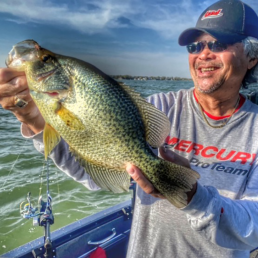Tips for Big-Time Spring Panfish
SHARE THIS POST
Ice fishing tactics aren’t just for the winter months. Bluegills and crappies are still ready to party under the surface, even when you’re rocking flip-flops and sunscreen in June, July and August. In fact, the same jigs and techniques you use in December (minus the snow) can be the ticket to an epic summer panfish haul. Talk about keeping it cool!
Search for secret weed beds
Want to catch the big ‘uns? It’s time to track down the VIP spots: healthy, green weeds like coontail and cabbage. These aquatic jungles are the perfect hangouts for hungry bluegills and monster crappies, which are basically all about that oxygen-rich, shady life.
Look for these lush weed beds in places like backwaters of rivers or near deep-water, inside turns in lakes. By midsummer, the weeds have grown tall enough to top out just below the surface, and the fish are hanging out just below them. This is where they can dine on zooplankton (tiny critters that crappies and bluegill like to eat) without anyone noticing. It’s like the perfect buffet with built-in shade!
If you’re near a lake or reservoir, keep an eye out for standing timber, too. These shady spots are gold mines.
What to fish with?
Getting ready to slay some springtime panfish? Here’s the lowdown: Simplicity is key. You don’t need anything fancy. Go for longer, medium-light rods to crank up the fun factor. I believe that a longer, 8-foot, medium-action JT Outdoors rod provides that extra action when a bluegill goes wild on the other end. It’s also easier to pull them out of the weeds with a rod heavier than an ultra-light.
Medium-pound test line is your friend here, so stick with 4-pound test for that super-sensitive touch. If you’re fishing around rocks or sunken trees (basically fish hideouts), you might want to bump it up to 6-pound. But let’s be real: Finesse is the name of the game.
Speaking of finesse…ice jigs are still the secret weapon in the summer heat! They may have been born for winter fishing, but when you dress them up with some live bait like wax worms or “spikes” (aka, maggots or Euro larvae), they’re absolutely irresistible to panfish. If the water’s clear, start with dark, natural colors like black. Once the algae blooms kick in, go bright: Chartreuse, orange and other high-visibility colors are great go-tos.
Are you enjoying this post?
You can be among the first to get the latest info on where to go, what to use and how to use it!
Here’s the cool part: Unlike regular hooks, ice jigs with the tiny hooks usually hook fish in the lip, which means you can easily catch-and-release the ones that don’t make the cut.
The approach: Stealthy moves for summer panfish
Once you’re all geared up and have located a promising weed bed (or a secret timber lay-down), it’s time to take the stealth approach. Forget casting; just gently place your float into the water, letting the bait drop straight down into those secret fish hideaways. Be stealthy! Avoid making big splashes or you might scare off the panfish.
Control your depth with a bobber stop, so the bait gets to the right spot and stays there. Let it rest for a second or give it a little jiggle. No bites? No problem. Keep moving and don’t wait around for the fish to come to you. Keep moving along the weed line, finding where the fish are hungry and ready to bite. Panfish aren’t shy; when you find them, they typically eat.
If the action slows, adjust your depth. Fish follow the zooplankton around, so you might need to go up or down a little to match their vertical snack attack. Fresh bait is essential, so don’t let those wax worms get too stale. Keep changing it up and fresh!
Looking for some new fishing techniques to try this season? You’ll find plenty of suggestions in every issue of MidWest Outdoors. Subscribe on our website.
MWO
SHARE THIS POST
You may also like...
Nothing found.
Did you enjoy this post?
You can be among the first to get the latest info on where to go, what to use and how to use it!
Ted Takasaki
Ted Takasaki is an International Fishing Hall of Fame professional angler who has been featured in many national outdoor magazines and television shows. Takasaki has appeared in front of thousands of angling enthusiasts and is considered one of America’s top walleye and multispecies anglers. Follow him on his Facebook page.
